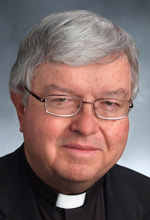Q. A question about religion has always puzzled me: Jesus was a Jew; when did he become a Catholic? (Afton, Iowa)
A. You are right: Jesus was a Jew. He was born a Jew, brought up a Jew, was steeped in the Jewish Scriptures and, as we read in Luke (4:16), went to the synagogue on the Sabbath day “according to his custom.”
During the temptations in the desert (Mt 4:1-11), Jesus quotes three times from the Old Testament book of Deuteronomy. In the only passage in which he reads, Jesus unrolls a scroll in the synagogue at Nazareth, quotes from the Book of Isaiah and refers the passage to himself (Lk 4:16-21).
In several Gospel narratives, Jesus claims divine prerogatives (in Mark 2, where he forgives the paralytic’s sins before curing him). Because of that, some Jews accused Jesus of blasphemy and rejected him outright.
Nevertheless, in the early years following the death of Christ, Christianity was viewed as a sect within Judaism. Its followers were called “Nazarenes” or people of “The Way”, but they continued to practice Jewish rituals. (At the start of Chapter 3 of the Acts of the Apostles, we read that “Peter and John were going up to the temple area for the 3 o’clock hour of prayer.”)
The split between Christianity and Judaism was not so much an event as a process, one that evolved gradually during the first century of the church’s existence.
One key moment in that process came with the Council of Jerusalem in 50 A.D., when it was decided that gentiles could be admitted to the church without being circumcised. During the decades that followed, the relationship between Jews and Christians varied. Sometimes, Christians were expelled from synagogues; at other times, they left voluntarily.
To answer your question as to when Jesus “became a Catholic,” I would say never. He couldn’t have, in fact. The church was first called Catholic only by Ignatius of Antioch in about 100 A.D. (The term meant “universal”; Jesus and his disciples had preached that salvation was meant for all.)
Christ came not to eradicate the Jewish religion but to complete it by creating a monotheistic faith community that would be open to people of all races. (He says this in Matthew 5:17: “Do not think that I have come to abolish the law or the prophets. I have come not to abolish but to fulfill.”)
All of this would indicate that the attitude of Catholics toward Jews ought to be one of respect and gratitude. Christianity was built upon the foundation of Judaism. (Pius XI said that “spiritually we are all Semites.”)
In the words of the Second Vatican Council: “In her rejection of every persecution against any person, the church, mindful of the inheritance she shares with the Jews … decries hatred, persecutions and displays of anti-Semitism directed against Jews at any time and by anyone.”
Q. In our parish and in some other churches I’ve visited, I notice that the bells are no longer rung when the host and the chalice are elevated. Why would centuries of tradition be eliminated? The Mass is about sounds, the smell of the candles and the emotions that the laity feel during the service. Don’t those who make the decisions care how the rest of us feel about all of the changes that have taken place? (Utah)
A. Since the 1969 revisions in the Mass under Pope Paul VI, ringing of bells by the Mass server at the elevation has been optional. The General Instruction of the Roman Missal says in No. 150 that this is left to the discretion of the priest. Most parishes today, I would think, do not use bells.
A quick history lesson might help. Ringing bells at the elevation began in the early part of the 13th century. At that time, few people received Communion regularly at Mass, so few, in fact, that the church had to mandate its reception at least once a year.
Most worshippers in those days went to Mass primarily to adore Christ rather than to receive him. Because of that, the central focus was seen as the elevation, when the consecrated species were lifted high to be reverenced.
Today, instead, reception of holy Communion is considered the natural fulfillment of the sacrifice and the act that unites us most intimately to the risen Christ. Bells at the elevation might be seen as misplacing the emphasis.
But bells remain an option, particularly if a great majority of the worshippers felt that their use would highlight the solemnity of the Mass and prompt deeper reverence.
***
Questions may be sent to Father Kenneth Doyle at askfatherdoyle@gmail.com and 40 Hopewell St., Albany, NY 12208.
PREVIOUS: In the month honoring Mary, a lifetime of memories
NEXT: Focusing on self rather than Jesus makes prayer boring, pope says




Share this story